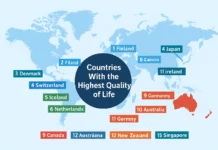Corruption remains one of the most pressing challenges facing governments and societies worldwide. It slows economic growth, reduces public trust, and undermines democracy. According to Transparency International’s Corruption Perceptions Index (CPI), several countries consistently rank among the most corrupt because of weak institutions, political instability, and poor accountability.
Corruption doesn’t just cost money—it erodes trust, destabilizes economies, and affects millions of lives. We reveal the 10 most corrupt countries, analyze why corruption persists, and highlight its impact on citizens and the world.
The 10 Most Corrupt Countries (2025 Reports)
| Rank | Country | CPI Score* | Key Corruption Issues |
|---|---|---|---|
| 1 | Somalia | 12/100 | Weak governance, bribery, and a lack of rule of law |
| 2 | South Sudan | 12/100 | Civil conflict, nepotism, and political instability |
| 3 | Syria | 14/100 | Authoritarian control, opaque finances, war-related corruption |
| 4 | Yemen | 15/100 | Political turmoil, aid diversion, widespread bribery |
| 5 | Venezuela | 14/100 | Mismanagement of oil wealth, elite corruption, and economic collapse |
| 6 | Sudan | 16/100 | Patronage networks, weak institutions, and political instability |
| 7 | Equatorial Guinea | 16/100 | Mismanagement of natural resources, elite enrichment |
| 8 | Afghanistan | 16/100 | Weak governance, bribery, and ongoing conflict |
| 9 | North Korea | 17/100 | Totalitarian regime, opaque economy, systemic corruption |
| 10 | Philippines | 33/100 | Flood control scandal, widespread bribery, and mismanagement of public funds |
*CPI scores range from 0 (most corrupt) to 100 (least corrupt).
Root Causes of High Corruption
- Weak Institutions: Nations lacking strong oversight, effective legal systems, and transparency are more at risk.
- Political Instability: Conflicts, coups, and frequent political shifts create opportunities for graft.
- Economic Mismanagement: Misuse of natural resources, public funds, and government projects fuels corruption.
- Lack of Accountability: Bribery, nepotism, and opaque decision-making are common in both public and private sectors.
Philippines Case Study: Flood Control Scandal
The Philippines has faced criticism for widespread corruption in public infrastructure projects, particularly in flood control initiatives. Mismanaged budgets and questionable procurement practices have intensified urban flooding, highlighting the direct impact of corruption on citizens’ safety and daily lives.
Consequences of Corruption
- Economic: Discourages investment, increases inequality, and reduces government efficiency.
- Social: Limits access to healthcare, education, and essential services.
- Political: Erodes trust in institutions, fuels public frustration, and can destabilize communities.
Frequently Asked Questions (FAQs)
How is corruption measured globally?
The Corruption Perceptions Index (CPI) scores countries from 0 (highly corrupt) to 100 (very clean) based on expert assessments and surveys of business executives.
Can corruption rankings change over time?
Yes. CPI scores can rise or fall depending on policy changes, transparency initiatives, and improvements in governance.
How can citizens fight corruption?
By reporting bribery, supporting transparency laws, engaging in civil society advocacy, and holding leaders accountable.
Why is this article evergreen content?
Corruption is a persistent global issue. Although specific rankings may change, the causes, consequences, and solutions remain relevant, providing lasting value.
Conclusion
Corruption harms governance, weakens economies, and touches the daily lives of citizens. Including countries like the Philippines in the ranking emphasizes that no nation is immune. Identifying the countries at highest risk of corruption, understanding why it persists, and examining its effects on societies are essential for promoting transparency and accountability worldwide.
- The 10 Biggest Problems the World Is Facing Today
- Top 10 Philippine Agencies With High Corruption Risk
- Top 15 Countries With the Highest Quality of Life















